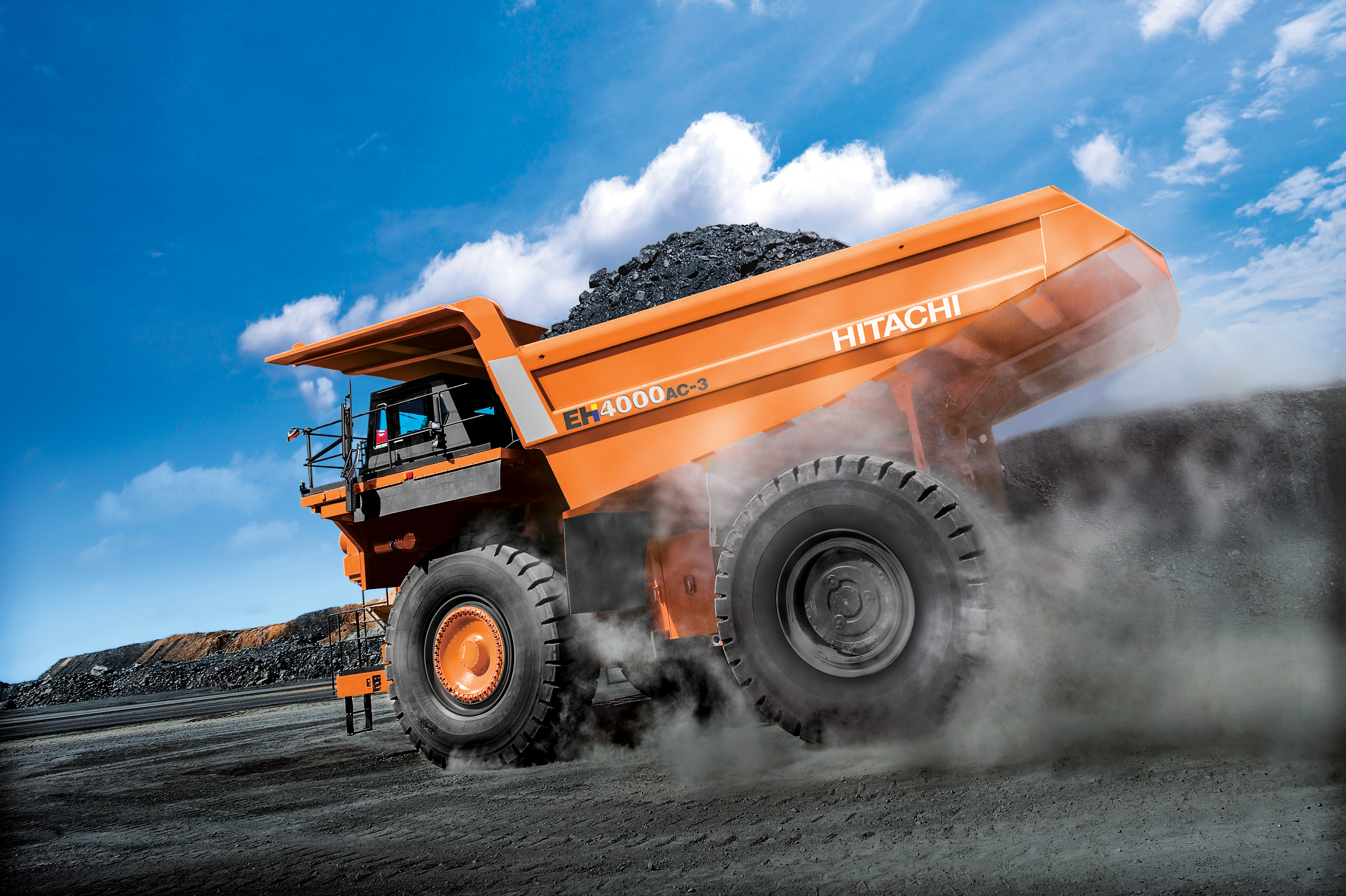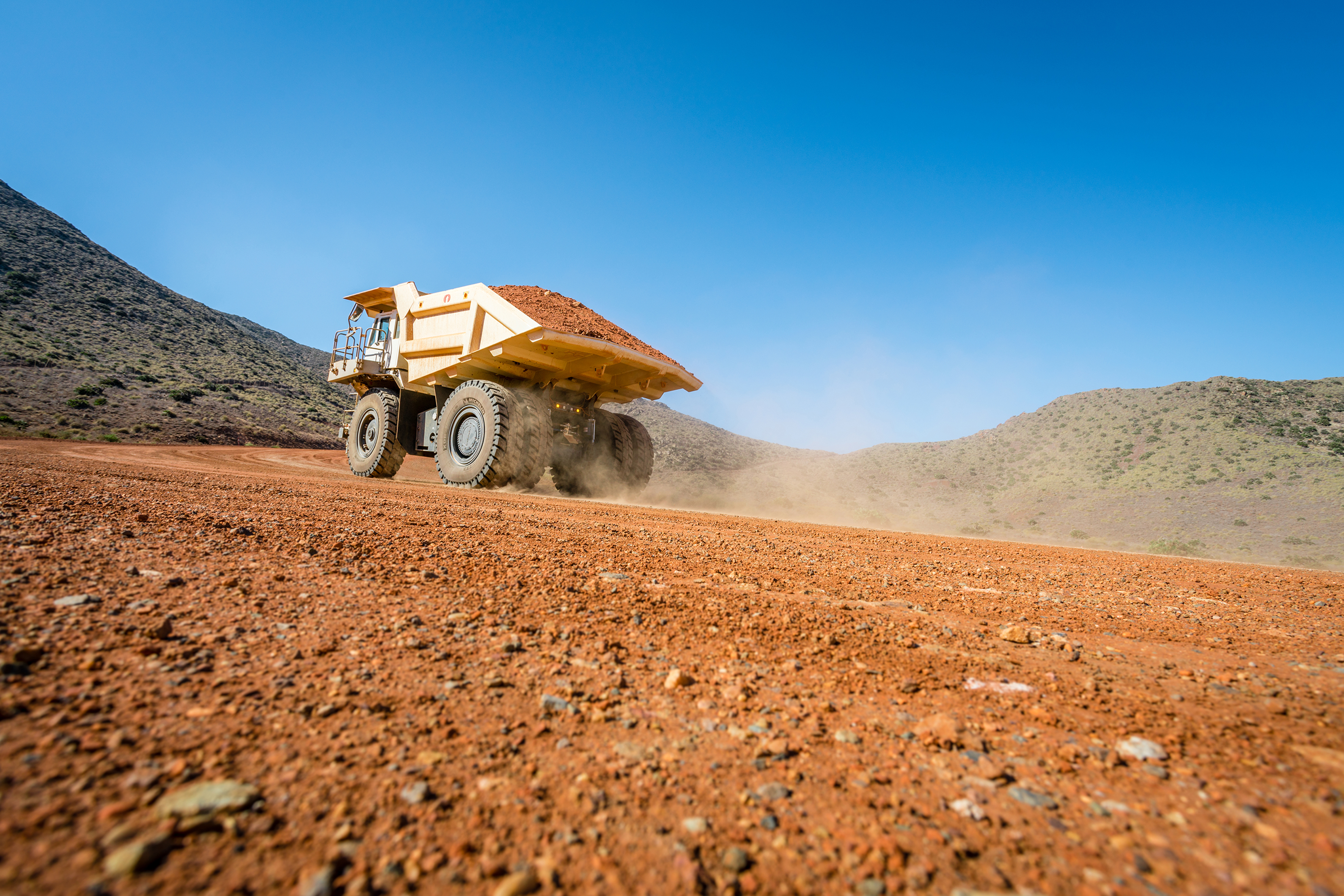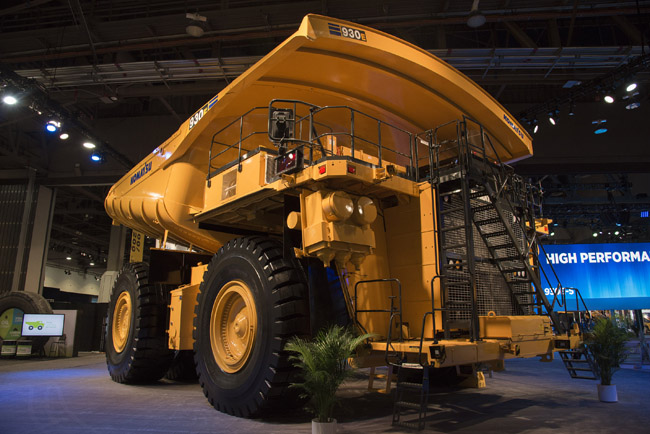Caterpillar expanded its electric drive options with the introduction of the 291-tonne 794AC model. Courtesy of Caterpillar
In the 20-odd years since large electric-drive haul trucks first started appearing on mine sites, the electric design concept has come to dominate the market for trucks of 200 or more tons (181 tonnes). But there is always room for improvement. Recent designs from some major manufacturers make use of improved technology, put existing technology in new configurations, and make the trucks safer and smoother to use.
In today’s mine haul truck drives, electric is synonymous with alternating current motors. Komatsu America Corporation switched its last electric truck from direct current (DC) to alternating current (AC) in 2014 with the introduction of the 730E-8. “I doubt you will ever see another DC drive mining truck be released by anybody going forward,” said Tom Stedman, product manager of mining trucks at Komatsu. AC drives are lighter, brushless, easier to maintain and more reliable than their DC counterparts.
Fuel and emissions
Over time, AC drive technology has seen incremental improvements. Stedman said that faster, smaller microprocessors have promoted better fuel economy. “That advancement over the last five to eight years has allowed us to really fine-tune the engine output power to the demand from the drive system,” he said. “So there’s very little variation now between what the engine is putting out at any given time and what the drive system needs to optimize its performance.” One of Komatsu’s mining customers, he said, had seen a four-per cent reduction in fuel use as a result.
The latest and biggest change to the Komatsu 930E was driven by the U.S. Environmental Protection Agency’s Tier 4 Final engine requirements, which come into effect on Jan. 1, 2018. The Cummins engines in the truck’s fifth-generation design reduce particulate matter emissions down to 0.04 grams per kilowatt hour.
“Currently our plan is to have the 930E-5 commercially available in the second half of 2017,” said Stedman. As the truck model most popular in the United States and Canada, it will be the first to comply with Tier 4 Final standards. Komatsu is also developing a Tier 4 Final 830E, a 240-ton (217-tonne) truck also heavily used in North America.
“There’s also talk about Australia implementing emission standards which would be equivalent to the U.S. EPA,” said Stedman. “So you may see in two or three years that trucks going to Australia will have the same requirements for emissions – particularly eastern Australia, where the population base is.”
The engine is not the only new feature on the 930E-5. “We have removed the mechanical fan that we had for cooling the wheel motors and control group. We’ve also updated the dynamic retarding cooling fans. All machine cooling requirements are now managed through AC driven cooling fans,” said Stedman. The AC motor is more efficient and reliable, according to Stedman.
The other advantage to the AC motor is that it allows the cooling fans to run only when needed. “If you have a fan blade that’s direct drive from something, that fan is going to turn the same all the time,” said Stedman. “It’s a mechanical connection. So let’s say you’re working at night, or maybe you’re working in Canada and it’s winter time, and you really don’t need much cooling air. What you can do with the AC motors is, you can have sensors on the truck that sense the temperature of all the components, and it can tell the computer, ‘This isn’t hot right now, so turn that fan off.’”
That removes some of the load from the drive system, which can then use less fuel. “That’s a big upgrade, we think,” said Stedman. “And all the Tier 4 model change products will have that technology.”

The newest updates on Hitachi’s 221-tonne EH4000AC-3 include enhanced object detection features. Courtesy of Hitachi
Safety and control
A recent update at Hitachi Construction & Mining Division looks at things from the operator’s perspective, enhancing its 360-degree object detection immediately around the truck. “The updated system now not only has a peripheral vision, but also has an audible alarm and a visual indication on the screen if there are any objects within close range,” said Brian Mace, manager of mining product marketing and applications at Hitachi. When the truck is traveling, an additional system warns the operator and, if needed, acts to avoid any potential collisions.
This system appears on the 221-tonne EH4000AC-3 introduced in 2014. Like other AC-3 trucks, it uses a drive system built completely by Hitachi. Free communication between engineers in different departments “allowed us to create some interesting and unique features on the truck,” said Mace.
The advantage of any AC drive setup is that each wheel motor can be controlled independently. For example, as Komatsu’s Stedman explained, if one wheel is spinning too fast, the system can reduce power to that wheel alone. Komatsu uses this to enhance traction and prevent brakes locking up in wet conditions.
Hitachi’s current assemblage of control features includes something similar, as well as pitch control, which helps limit rebounding when the truck hits a bump or stop, and a side-skid control feature that helps the operator steer the truck while turning. Mace noted that this is helpful not only to smooth out operators’ rides, but also to optimize autonomous haulage, which Hitachi is working on right now.

Liebherr’s new 100-tonne T236 offers the second generation of the company’s Litronic Plus AC drive system. Courtesy of Liebherr
New sizes
Manufacturers have been filling in the size gaps in their lines. In spring 2016, Komatsu introduced a 400-ton (363-tonne) truck, the 980E-4. “We got a lot of inquiries from customers about ‘Why don’t you guys do a 400-ton?’” said Stedman. That is the high end of the spectrum for Komatsu, Caterpillar and Liebherr, although the Belarusian company Belaz has been delivering an even larger truck, the 496-tonne Belaz 75710, since 2014.
Meanwhile, Liebherr and Caterpillar added smaller sizes. Liebherr’s new 100-tonne T236 comes equipped with an update on the Litronic Plus AC drive system. According to Liebherr, it is, “the first diesel electric truck in class incorporating an oil immersed braking system with four corner retarding capabilities.”
With its payload capacity of 291 tonnes, the new Caterpillar 794 AC is smaller than the 795F AC, Caterpillar’s first electric-drive truck, and comparable to the Komatsu 930E. It consists of a chassis originally developed by Unit Rig (since acquired by Cat) and the power train from the 795.
Caterpillar has been slower to adopt electric drives than its competitors. Sudhanshu Singh, product manager of large mining trucks, contests the claim that electric drive is inherently superior. “While AC technology, compared to DC, has improved electric drive efficiency,” he said, “the fact remains that mechanical drive in a truck application still delivers the highest system efficiency.” Singh said that the new electric drive truck was introduced to make it easier for customers to switch from similar competitors’ trucks.
Caterpillar has other philosophical differences with its competitors. Across manufacturers, new truck models use insulated-gate bipolar transistors (IGBTs) to vary the voltage sent to the motor. But the 794 AC uses IGBTs with a comparatively high voltage rating.
“In general, the lower the voltage rating of an IGBT, the lower the cost,” said John Ingle, marketing and performance manager of large mining trucks at Caterpillar. But the lower the voltage, the more IGBTs need to be connected to meet a large truck’s power demand. The sentiment at Caterpillar is that the additional power cables and busbars overcomplicate vehicle servicing. More importantly, higher voltage means lower current, which means less heat generation, smaller components and longer component life.
Like any well-appointed heavy equipment, all of these trucks come with basic monitoring systems as standard. At Cat, the Vital Information Management System 3G is included in the base machine, as is a cab display and a payload management system that stores payload and productivity data. Other systems, like the offboard software and the more extensive MineStar suite, are optional.
On Hitachi’s trucks, said Mace, “There’s always historical information of the operation, alarms, faults, payload historical data. Obviously there’s going to be some GPS information on there. And all that information is stored on the truck.”

Komatsu’s 930E-5 will be commercially available later in 2017. The new model will use AC motor cooling fans rather than mechanical ones. Courtesy of Komatsu
From there, accessing the data is up to the customer. Mace said that in the last few years, customers have started wirelessly downloading it from the truck. Other options for accessing the data include Hitachi’s telematics services and whatever management system the mine has put in place.
Komatsu’s KomTrax Plus uses satellite communications to broadcast web-accessible information from its large mining trucks. Alongside actual heat, pressure and other readings, the system maintains a history of normal operating parameters. The service and support program comes standard, as does the payload monitoring system PLM IV, which stores payload, cycle times, load count and fault codes.
Within the last two years, Komatsu has expanded to big data collection at several mine sites to meet demand for real-time analytics. This is still a niche project, but Stedman considers it the way of the future – in his view, one best suited to electric trucks. “You can do that with a mechanical drive,” said Stedman, “but we feel that the electric drive system provides a better platform to gather a great deal of information and we feel that information is inherently more precise.”
The engineers at Caterpillar, which has big data projects of its own, might disagree. But it seems clear, given customer demand and the work to date, that electric drive trucks will continue to provide a platform for innovation.





 The newest updates on Hitachi’s 221-tonne EH4000AC-3 include enhanced object detection features. Courtesy of Hitachi
The newest updates on Hitachi’s 221-tonne EH4000AC-3 include enhanced object detection features. Courtesy of Hitachi Liebherr’s new 100-tonne T236 offers the second generation of the company’s Litronic Plus AC drive system. Courtesy of Liebherr
Liebherr’s new 100-tonne T236 offers the second generation of the company’s Litronic Plus AC drive system. Courtesy of Liebherr Komatsu’s 930E-5 will be commercially available later in 2017. The new model will use AC motor cooling fans rather than mechanical ones. Courtesy of Komatsu
Komatsu’s 930E-5 will be commercially available later in 2017. The new model will use AC motor cooling fans rather than mechanical ones. Courtesy of Komatsu